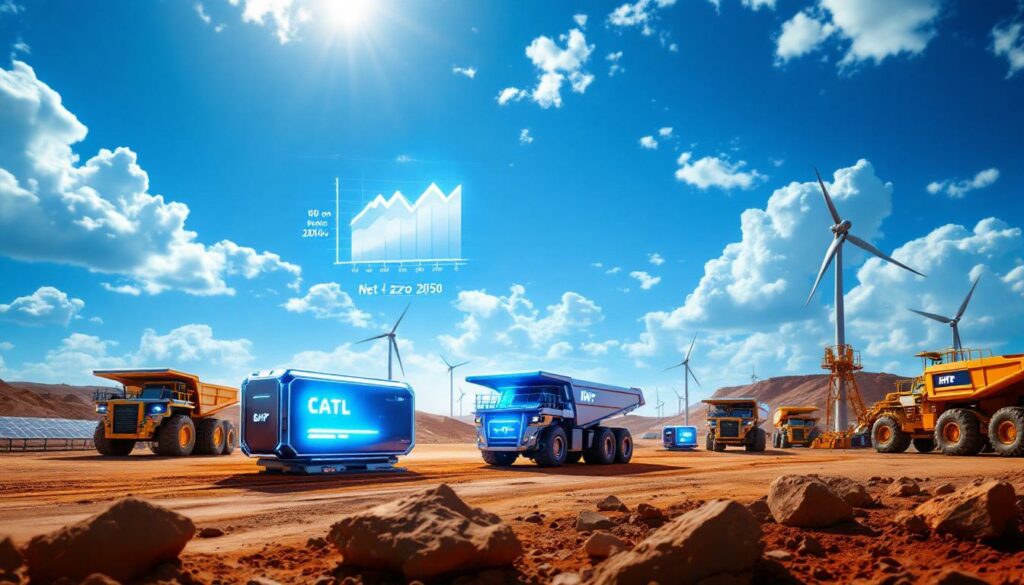How is the CATL-BHP Partnership Transforming Mining Sustainability?
The groundbreaking strategic alliance announced on July 20, 2025, between Contemporary Amperex Technology Co. Limited (CATL) and BHP represents a significant milestone in mining's sustainability journey. This partnership brings together CATL's battery expertise with BHP's mining operations knowledge, creating a powerful combination aimed at revolutionizing how mining equipment is powered and how resources are extracted.
The Strategic Alliance Between Battery Giant and Mining Leader
The partnership centers on five key development areas that promise to transform mining sustainability: specialized mining batteries, locomotive power solutions, fast-charging infrastructure, energy storage systems, and innovative battery recycling initiatives. These technologies will serve as the foundation for BHP's ambitious journey toward net-zero operations by 2050.
"These important relationships are further steps towards BHP meeting our decarbonisation ambitions for our operations and help drive transformative change within the global resources industry," stated Rashpal Bhatti, BHP's Chief Commercial Officer, highlighting the partnership's strategic importance.
CATL's expertise in advanced battery technology provides the technical foundation, while BHP contributes deep operational knowledge of mining environments and requirements. This collaboration addresses a critical gap in the mining industry—the need for battery systems specifically engineered for the harsh conditions and demanding power requirements of resource extraction operations.
"Together with forward-thinking mining companies like BHP, we aim to demonstrate how advanced battery technologies can decarbonize mining operations, logistics, and product delivery, accelerating a sustainable, efficient future while creating long-term value and transforming the global resources industry through innovation," explained Tan Libin, head of CATL's overseas business division.
What Makes This Partnership Strategically Significant?
The CATL-BHP development cooperation represents more than just a technological collaboration—it signals a fundamental shift in how mining companies approach sustainability and operational efficiency. By combining complementary expertise, both companies gain competitive advantages while accelerating the mining sector's transition toward carbon neutrality.
Industry Leaders Joining Forces
CATL brings its position as a global battery technology leader with cutting-edge innovations in energy storage and recycling methodologies. Their expertise in developing high-performance battery systems capable of withstanding extreme conditions makes them an ideal partner for mining applications.
BHP contributes its extensive operational knowledge and global mining footprint. As one of the world's largest diversified mining companies, BHP provides the real-world testing grounds and implementation pathways essential for successful deployment of battery technologies in mining environments.
Industry analysts note this partnership creates a powerful first-mover advantage in mining electrification. By developing proprietary systems specifically optimized for resource extraction, both companies position themselves at the forefront of mining's inevitable transition away from fossil fuels.
Decarbonization Targets and Timeline
The partnership aligns perfectly with BHP's public commitment to achieve net-zero operational greenhouse gas emissions by 2050. This goal requires a complete transformation of mining equipment that has traditionally relied on diesel power, representing one of the most significant technical challenges in the industry's sustainability journey.
According to mining sustainability experts, phased implementation of electrification technologies allows for gradual adaptation of operational practices, maintenance protocols, and workforce training. The initial focus will likely be on equipment with established electrification pathways, such as light vehicles and certain stationary equipment, before progressing to more challenging applications like heavy haul trucks and excavators.
By establishing clear performance metrics for emissions reduction and operational efficiency, the partnership creates accountability mechanisms that drive continual improvement. This approach helps BHP maintain its leadership position in sustainable mining practices while potentially influencing regulatory frameworks for the broader industry.
How Will This Partnership Transform Mining Operations?
The CATL-BHP collaboration addresses three critical areas of mining operations: equipment electrification, locomotive power systems, and charging infrastructure. Each component represents a significant technical challenge requiring specialized solutions beyond standard commercial applications.
Mining Equipment Electrification
Mining vehicles operate in exceptionally demanding conditions that push battery systems to their limits. The development of specialized battery technologies for heavy mining equipment must address several unique challenges:
- Environmental resilience: Systems must withstand extreme dust, vibration, temperature fluctuations, and potential exposure to corrosive materials
- Power density requirements: High energy and power density needed for heavy-duty applications like haul trucks carrying hundreds of tons of material
- Safety enhancements: Advanced thermal management and protective systems to prevent thermal runaway in confined mining spaces
- Operational continuity: Battery systems that support extended duty cycles with minimal downtime
The partnership builds upon BHP's previous electrification efforts with companies like Komatsu and Sandvik, applying lessons learned to develop next-generation solutions optimized for mining-specific requirements.
Locomotive Power Systems Development
Mining rail networks present unique opportunities for electrification due to their predictable routes and operational patterns. Battery-powered locomotives offer significant advantages over diesel alternatives:
- Emissions elimination: Removal of diesel exhaust from underground tunnels and mining corridors
- Maintenance reduction: Electric drivetrains with fewer moving parts requiring less frequent maintenance
- Noise reduction: Quieter operation improving working conditions and reducing noise pollution
- Regenerative braking: Energy recovery opportunities when traversing downhill segments with loaded materials
The partnership aims to develop locomotive battery systems with extended operational ranges suitable for the long hauls typical in mining operations. These systems will incorporate intelligent power management to optimize energy use during variable load conditions throughout transportation cycles.
Fast-Charging Infrastructure Innovation
Effective implementation of electric mining equipment requires specialized charging infrastructure adapted for mining environments. The partnership will develop:
- Ruggedized charging systems: Hardened technology capable of withstanding harsh mining conditions
- High-power delivery: Fast-charging capabilities that minimize operational downtime
- Grid-independent options: Solutions for remote mining sites with limited grid connectivity
- Renewable integration: Charging infrastructure designed to work with on-site renewable generation
This builds upon BHP's earlier collaboration with Tritium, which adapted DC fast chargers for mining applications in Queensland operations. The new partnership will likely develop next-generation systems with higher power ratings and enhanced durability.
What Circular Economy Initiatives Are Being Developed?
A distinctive aspect of the CATL-BHP partnership is its emphasis on creating closed-loop systems for battery materials. This approach addresses both sustainability goals and supply security concerns by establishing circular material flows throughout the battery lifecycle.
Battery Recycling Processes
The partnership will leverage BHP's existing expertise in copper processing to develop specialized recycling methodologies for mining batteries. This strategic integration offers several advantages:
- Material recovery efficiency: Utilization of metallurgical expertise to maximize recovery rates for lithium, cobalt, nickel, and other critical battery materials
- Waste stream reduction: Minimization of environmental impact from end-of-life battery disposal
- Process innovation: Development of mining-specific recycling techniques optimized for the unique composition of heavy-duty battery systems
- Scale economics: Potential to process both mining batteries and consumer electronics batteries, creating operational efficiencies
Mining battery recycling presents unique challenges compared to consumer electronics batteries due to their larger size, specialized chemistries, and ruggedized construction. The partnership will develop tailored processes that address these differences while maximizing material recovery.
Sustainable Value Chain Development
Beyond recycling, the partnership aims to establish comprehensive traceability systems that track battery materials throughout their lifecycle. This approach creates multiple sustainability benefits:
- Material provenance verification: Documentation of responsibly sourced materials from extraction through recycling
- Carbon footprint reduction: Quantifiable sustainability improvements through reduced virgin material extraction
- Supply chain resilience: Decreased dependence on geopolitically complex material sources
- Lifecycle optimization: Design improvements based on performance and recycling data
By establishing mining battery systems with designed-for-recycling principles, the partnership creates a model for sustainable material management that could influence broader industry practices.
What Previous Electrification Efforts Has BHP Undertaken?
The CATL partnership builds upon BHP's systematic approach to mining electrification over the past several years. These initiatives provide valuable foundation experience and implementation learnings that will inform the new collaboration.
Historical Electrification Initiatives
BHP has established several key partnerships and implemented multiple electrification projects:
- 2021 Komatsu Alliance: Focused on developing electric alternatives for mining trucks, replacing diesel-powered haul trucks with battery-electric options
- 2021 Tritium Charging Implementation: Adaptation of commercial DC fast chargers for mining applications, with installations at BHP's Queensland operations
- 2022 Sandvik Equipment Acquisition: Procurement of battery-powered mining vehicles for underground operations, reducing diesel particulate exposure for workers
- 2023 Chilean Operations Electrification: Implementation of electric mining trucks in South American sites, demonstrating viability in different operational contexts
These initiatives represent a progressive approach to electrification, starting with well-established applications before advancing to more challenging use cases. The staged implementation has allowed BHP to develop operational expertise while managing technology transition risks.
Technology Adaptation Challenges
BHP's previous electrification efforts have highlighted several key challenges that the CATL partnership will need to address:
- Mining-specific modifications: Standard electric vehicle technologies require significant customization for mining applications due to environmental conditions, duty cycles, and power requirements
- Performance verification: Rigorous testing protocols must validate battery performance and safety under extreme mining conditions
- Operational integration: Workflow adjustments are necessary for charging schedules, maintenance procedures, and operational planning
- Workforce development: Technical staff require specialized training in high-voltage systems, battery management, and electrical troubleshooting
These challenges underscore the importance of developing purpose-built mining electrification solutions rather than attempting to adapt standard commercial technologies—precisely the focus of the CATL-BHP development cooperation.
What Are the Expected Industry-Wide Impacts?
The CATL-BHP partnership has implications extending far beyond these two companies. As industry leaders, their technological developments and implementation approaches will likely influence broader industry practices and establish new benchmarks for mining sustainability.
Mining Sector Transformation
Industry analysts anticipate several transformative effects from this partnership:
- Technology standardization: The solutions developed may establish new benchmarks for mining equipment electrification, potentially influencing equipment specifications across the industry
- Competitive acceleration: Other major mining companies will likely accelerate their own electrification initiatives in response, creating positive competition for sustainability leadership
- Supply chain adaptation: Mining equipment manufacturers will face increased pressure to develop electric alternatives to traditional diesel-powered machinery
- Skills evolution: The industry workforce will gradually shift toward electrical engineering expertise rather than traditional mechanical systems
This transformation represents one of the most significant technological transitions in mining since the introduction of computer-controlled equipment in the late 20th century.
Global Sustainability Implications
The environmental impact of this partnership extends beyond BHP's operations:
- Emissions reduction scale: Given BHP's global operational footprint, successful implementation could significantly reduce mining-related greenhouse gas emissions
- Technology transfer opportunities: Innovations developed for mining may find applications in other heavy industries facing similar electrification challenges
- Supply chain decarbonization: Minerals extracted using electrified equipment will have lower embedded carbon, benefiting downstream manufacturers concerned with scope 3 emissions
- Regulatory influence: Successful implementation may inform future regulatory frameworks for mining emissions and sustainability requirements
Mining industry sustainability experts note that electrification represents the single most impactful pathway for reducing the sector's direct emissions, making partnerships like this essential for achieving global climate goals.
How Does This Partnership Address Battery Material Sourcing?
One of the most intriguing aspects of the CATL-BHP partnership is its potential to create vertical integration between mineral extraction and battery manufacturing—addressing critical supply chain vulnerabilities while enhancing sustainability.
Critical Mineral Supply Chain Integration
The partnership creates several strategic opportunities for material integration:
- Vertical coordination: Direct connection between BHP's mining outputs (particularly copper, nickel, and potentially lithium) with CATL's manufacturing requirements
- Responsible sourcing frameworks: Development of enhanced environmental and ethical standards for battery materials extracted specifically for CATL's supply chain
- Supply risk mitigation: Reduction of dependence on geopolitically complex supply regions through preferential supply arrangements
- Traceability implementation: Creation of systems tracking critical minerals from BHP extraction through CATL battery production
This integration addresses growing concerns about battery material provenance and sustainability, particularly as automotive and electronics manufacturers face increasing scrutiny regarding their supply chains.
Australian Mining Operations Focus
BHP's significant Australian operations provide an ideal testing ground for the partnership's technologies:
- Queensland implementation priority: Initial deployment likely at BHP's Queensland facilities, building on existing electrification efforts with Tritium
- Copper operations leverage: Strategic utilization of BHP's copper expertise for battery recycling initiatives, creating material recovery synergies
- Regional economic benefits: Job creation in advanced mining technology, battery manufacturing, and recycling sectors across Australia
- Export potential development: Positioning Australia as a showcase for mining sustainability innovation, potentially creating technology export opportunities
Mining industry observers note that Australia's combination of abundant mineral resources, technical expertise, and stable regulatory environment makes it an ideal location for pioneering mining electrification technologies.
What Executive Perspectives Frame This Partnership's Vision?
Leadership statements from both companies provide valuable insights into the strategic thinking behind this collaboration and its long-term objectives.
Leadership Insights on Strategic Direction
Both companies' executives emphasize the transformative potential of this partnership:
"These important relationships are further steps towards BHP meeting our decarbonisation ambitions for our operations and help drive transformative change within the global resources industry." – Rashpal Bhatti, BHP Chief Commercial Officer
This statement positions the partnership within BHP's broader sustainability strategy while highlighting its industry-wide implications.
"Together with forward-thinking mining companies like BHP, we aim to demonstrate how advanced battery technologies can decarbonize mining operations, logistics, and product delivery, accelerating a sustainable, efficient future while creating long-term value and transforming the global resources industry through innovation." – Tan Libin, CATL Overseas Business Head
CATL's perspective emphasizes the demonstration effect of the partnership—showing how battery technologies can practically transform mining operations while creating business value.
The executives' focus on "transformative change" and "innovation" signals this partnership aims to fundamentally reimagine mining operations rather than simply implementing incremental improvements to existing systems.
FAQs About the CATL-BHP Partnership
What timeline has been established for implementing these technologies?
While specific deployment schedules haven't been publicly disclosed, the partnership builds on BHP's existing electrification initiatives that began in 2021. Industry analysts anticipate accelerated implementation in the 2025-2030 timeframe, with initial deployments focused on equipment categories with established electrification pathways before progressing to more challenging applications.
How will these technologies perform in extreme mining environments?
The partnership specifically focuses on developing battery systems engineered for mining conditions, addressing challenges like dust, vibration, temperature extremes, and continuous heavy-duty operation cycles. Previous mining electrification efforts have demonstrated the importance of ruggedized designs and enhanced cooling systems to maintain performance in harsh environments.
What economic benefits might result from mining electrification?
Beyond environmental advantages, electrified mining operations typically experience reduced maintenance costs, lower energy expenses, improved equipment reliability, and enhanced worker safety conditions. The elimination of diesel fuel represents a significant operational cost reduction, while electric drivetrains typically require less frequent maintenance than combustion engines.
How will battery recycling initiatives connect with mining operations?
The collaboration will leverage BHP's metallurgical expertise, particularly in copper processing, to develop specialized recycling systems for mining batteries. This creates circular material flows where critical minerals extracted by BHP may eventually return to the same facilities for recycling and reintroduction into the battery supply chain.
Will these technologies be made available to other mining companies?
While initially developed for BHP's operations, successful innovations could potentially be commercialized more broadly, accelerating industry-wide adoption of sustainable mining technologies. The partnership may follow patterns established in other industries where initial proprietary technologies eventually become available through licensing or commercial offerings.
Disclaimer:
This article contains forward-looking statements regarding the implementation and impact of mining electrification technologies. Actual results may vary based on technological developments, market conditions, regulatory changes, and operational factors. Readers should not consider this analysis as financial or investment advice.
Want to Catch the Next Major ASX Discovery?
Discovery Alert's proprietary Discovery IQ model offers real-time notifications when significant mineral discoveries are announced on the ASX, giving you an immediate edge in identifying potential investment opportunities. Explore historic examples of exceptional returns from major discoveries on our dedicated discoveries page and position yourself ahead of the market.




